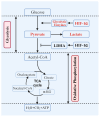The Physiological Functions and Therapeutic Potential of Hypoxia-Inducible Factor-1α in Vascular Calcification
- PMID: 39766299
- PMCID: PMC11674127
- DOI: 10.3390/biom14121592
The Physiological Functions and Therapeutic Potential of Hypoxia-Inducible Factor-1α in Vascular Calcification
Abstract
HIF-1α plays a crucial regulatory role in vascular calcification (VC), primarily influencing the osteogenic differentiation of VSMCs through oxygen-sensing mechanisms. Under hypoxic conditions, the stability of HIF-1α increases, avoiding PHD and VHL protein-mediated degradation, which promotes its accumulation in cells and then activates gene expressions related to calcification. Additionally, HIF-1α modulates the metabolic state of VSMCs by regulating the pathways that govern the switch between glycolysis and oxidative phosphorylation, thereby further advancing the calcification process. The interaction between HIF-1α and other signaling pathways, such as nuclear factor-κB, Notch, and Wnt/β-catenin, creates a complex regulatory network that serves as a critical driving force in VC. Therefore, a deeper understanding of the role and regulatory mechanism of the HIF-1α signaling during the development and progression of VC is of great significance, as it is not only a key molecular marker for understanding the pathological mechanisms of VC but also represents a promising target for future anti-calcification therapies.
Keywords: energy metabolism; hypoxia-inducible factor-1α; therapeutic target; vascular calcification; vascular smooth muscle cell.
Conflict of interest statement
The authors declare no conflicts of interest.
Figures









Similar articles
-
HIF-1α/PDK4/autophagy pathway protects against advanced glycation end-products induced vascular smooth muscle cell calcification.Biochem Biophys Res Commun. 2019 Sep 24;517(3):470-476. doi: 10.1016/j.bbrc.2019.07.102. Epub 2019 Jul 31. Biochem Biophys Res Commun. 2019. PMID: 31376939
-
Hypoxia-inducible factor-1 plays a role in phosphate-induced vascular smooth muscle cell calcification.Kidney Int. 2016 Sep;90(3):598-609. doi: 10.1016/j.kint.2016.05.020. Epub 2016 Jul 26. Kidney Int. 2016. PMID: 27470678
-
Advanced glycation end products accelerate calcification in VSMCs through HIF-1α/PDK4 activation and suppress glucose metabolism.Sci Rep. 2018 Sep 13;8(1):13730. doi: 10.1038/s41598-018-31877-6. Sci Rep. 2018. PMID: 30213959 Free PMC article.
-
Role of prolyl hydroxylase/HIF-1 signaling in vascular calcification.Clin Kidney J. 2022 Oct 15;16(2):205-209. doi: 10.1093/ckj/sfac224. eCollection 2023 Feb. Clin Kidney J. 2022. PMID: 36755843 Free PMC article. Review.
-
Signaling pathways involved in vascular smooth muscle cell calcification during hyperphosphatemia.Cell Mol Life Sci. 2019 Jun;76(11):2077-2091. doi: 10.1007/s00018-019-03054-z. Epub 2019 Mar 18. Cell Mol Life Sci. 2019. PMID: 30887097 Free PMC article. Review.
Cited by
-
Dual-Faced Role of GDF6 in Cancer: Mechanistic Insights into Its Context-Dependent Regulation of Metastasis and Immune Evasion Across Human Malignancies.Curr Issues Mol Biol. 2025 Apr 2;47(4):249. doi: 10.3390/cimb47040249. Curr Issues Mol Biol. 2025. PMID: 40699648 Free PMC article.
References
Publication types
MeSH terms
Substances
Grants and funding
LinkOut - more resources
Full Text Sources

